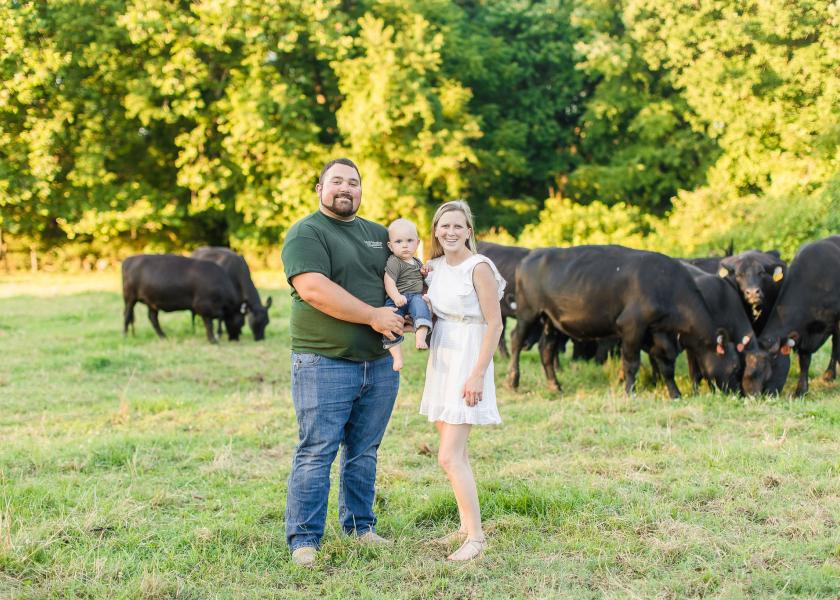Paving Their Own Way: Young Producers Diversity to Find Their Niche

“Keep your head up and follow through,” says Jenell McHenry.
For young farmers and ranchers starting out, it’s not always easy to get into the business with less capital to leverage and competition with larger operations.
For Joey and Jenell McHenry, finding their niche has allowed them to plant their stakes near Kennedyville, Md., and build a diversified operation that continues to pick up steam.
Raised on a dairy farm, Joey gained experience with cattle working alongside his father and grandfather as a fourth-generation producer in the area.
Dairy steers were also fed and finished on the farm and sold at a local sale barn as added income. Though the dairy farm has since ceased, the operation has shifted its focus to beef production.
Understanding there is “no guarantee” at the livestock auction and by only selling a few animals at a time, the McHenrys decided it was time for a change in their beef marketing plan. In 2019, Joey and Jenell chose to take a direct-to-consumer approach by starting McHenry’s Beef to market their finished, frozen beef, both by the cut and in quarters, halves and wholes.
Using a crossbred herd of mainly Angus and Charolais genetics, the McHenrys grow their cattle on pasture and finish them on grain grown on the farm. When finished, the animals are taken to a nearby USDA-inspected processing facility, packaged and given the McHenry’s Beef label.
Their locally-grown beef, available for farm pickup and delivery, has become popular in the area, with their location within driving distance of Annapolis, Md., the Chesapeake Bay area, New Jersey, Delaware and Pennsylvania. They also provide beef to a couple local restaurants in the area.
McHenry’s Beef continues to grow and look toward expansion in the future, while keeping a sense of community as a top priority.
“If I could have a feedlot or make it work in one of the old dairy barns around here, feed maybe 500 to 1,000 a year, it would help out the people around our area that have nowhere to take their animals,” Joey says.
The McHenrys plan to continue growing their current business model in the short-term, and in the long-term, they hope to open their own processing facility and have a meat locker on their farm.
While their proximity to populated areas is valuable to the beef business customer base, Joey describes the challenges of their area in overall beef production.
“There’s really no cattle equipment. It’s hard to find a good nutritionist. It’s hard to find somebody who’s got the right minerals and supplements,” Joey explains.
Their herd of around 100 cows is considered large, compared to many neighboring cattle producers with 10 to 15 head.
Along with the cattle and beef business, Joey operates around 500 owned and rented row crop acres and runs a custom harvest crew that covers nearly 4,000 acres.
The custom harvesting business arose as a solution to a challenge Joey saw on the farm. Timeliness and price of a custom harvest crew became deciding factors, leading to Joey buying a combine to harvest his family’s acres. This expanded to include neighboring farms and has served as a valuable piece of their diversified operation.
“Don’t worry about what everyone else is doing. Worry about what works best in your operation and what works best for you,” Joey says this was valuable advice he received early on.
A positive image and following through are extremely important as young producers, Jenell adds.
“We had a challenge as young farmers, getting respect, but once we fulfilled what we were asked to do, and we were able to move the product, we were able to get that respect from a processing plant, which allowed us to be where we are today,” Jenell says.
As young producers return to a family operation or start out on their own, the uphill climb might be just beginning.
“Just keep your head up high,” Jenell says. “Those crazy ideas that you have, if you’re that interested and that driven, find those baby steps it takes to get there and continue to push. There’s definitely times where we took one step forward and five steps back, but that’s just how business is really in any industry.”
Challenges aside, the McHenrys feel fortunate to raise their son on the farm and work together as a family. Jenell says, “It’s what we live for.”







